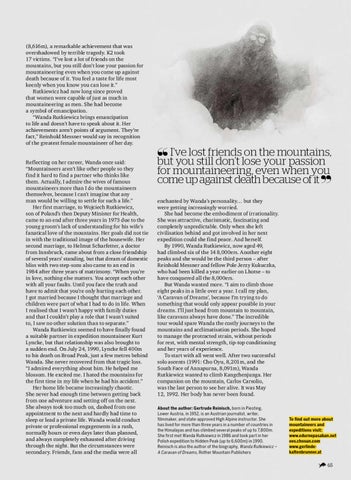(8,616m), a remarkable achievement that was overshadowed by terrible tragedy. K2 took 17 victims. “I’ve lost a lot of friends on the mountains, but you still don’t lose your passion for mountaineering even when you come up against death because of it. You feel a taste for life most keenly when you know you can lose it.” Rutkiewicz had now long since proved that women were capable of just as much in mountaineering as men. She had become a symbol of emancipation. “Wanda Rutkiewicz brings emancipation to life and doesn’t have to speak about it. Her achievements aren’t points of argument. They’re fact,” Reinhold Messner would say in recognition of the greatest female mountaineer of her day. Reflecting on her career, Wanda once said: “Mountaineers aren’t like other people so they find it hard to find a partner who thinks like them. Actually, I admire the wives of famous mountaineers more than I do the mountaineers themselves, because I can’t imagine that any man would be willing to settle for such a life.” Her first marriage, to Wojciech Rutkiewicz, son of Poland’s then Deputy Minister for Health, came to an end after three years in 1973 due to the young groom’s lack of understanding for his wife’s fanatical love of the mountains. Her goals did not tie in with the traditional image of the housewife. Her second marriage, to Helmut Scharfetter, a doctor from Innsbruck, came about from a close friendship of several years’ standing, but that dream of domestic bliss with two step-sons also came to an end in 1984 after three years of matrimony. “When you’re in love, nothing else matters. You accept each other with all your faults. Until you face the truth and have to admit that you’re only hurting each other. I got married because I thought that marriage and children were part of what I had to do in life. When I realised that I wasn’t happy with family duties and that I couldn’t play a role that I wasn’t suited to, I saw no other solution than to separate.” Wanda Rutkiewicz seemed to have finally found a suitable partner in expedition mountaineer Kurt Lyncke, but that relationship was also brought to a sudden end. On July 24, 1990, Lyncke fell 400m to his death on Broad Peak, just a few metres behind Wanda. She never recovered from that tragic loss. “I admired everything about him. He helped me blossom. He excited me. I hated the mountains for the first time in my life when he had his accident.” Her home life became increasingly chaotic. She never had enough time between getting back from one adventure and setting off on the next. She always took too much on, dashed from one appointment to the next and hardly had time to sleep or lead a private life. Wanda would conduct private or professional engagements in a rush, normally hours or even days later than planned, and always completely exhausted after driving through the night. But the circumstances were secondary. Friends, fans and the media were all
“ I’ve lost friends on the mountains, but you still don’t lose your passion for mountaineering, even when you come up against death because of it ” enchanted by Wanda’s personality… but they were getting increasingly worried. She had become the embodiment of irrationality. She was attractive, charismatic, fascinating and completely unpredictable. Only when she left civilisation behind and got involved in her next expedition could she find peace. And herself. By 1990, Wanda Rutkiewicz, now aged 49, had climbed six of the 14 8,000ers. Another eight peaks and she would be the third person – after Reinhold Messner and fellow Pole Jerzy Kukuczka, who had been killed a year earlier on Lhotse – to have conquered all the 8,000ers. But Wanda wanted more. “I aim to climb those eight peaks in a little over a year. I call my plan, ‘A Caravan of Dreams’, because I’m trying to do something that would only appear possible in your dreams. I’ll just head from mountain to mountain, like caravans always have done.” The incredible tour would spare Wanda the costly journeys to the mountains and acclimatisation periods. She hoped to manage the protracted strain, without periods for rest, with mental strength, tip-top conditioning and her years of experience. To start with all went well. After two successful solo ascents (1991: Cho Oyu, 8,201m, and the South Face of Annapurna, 8,091m), Wanda Rutkiewicz wanted to climb Kangchenjunga. Her companion on the mountain, Carlos Carsolio, was the last person to see her alive. It was May 12, 1992. Her body has never been found. About the author: Gertrude Reinisch, born in Piesting, Lower Austria, in 1952, is an Austrian journalist, writer, filmmaker, and state-approved High Alpine instructor. She has lived for more than three years in a number of countries in the Himalayas and has climbed several peaks of up to 7,800m. She first met Wanda Rutkiewicz in 1986 and took part in her Polish expedition to Hidden Peak (up to 6,600m) in 1990. Reinisch is also the author of the biography, Wanda Rutkiewicz – A Caravan of Dreams, Rother Mountain Publishers
To find out more about mountaineers and expeditions visit: www.edurnepasaban.net oes.chosun.com www.gerlindekaltenbrunner.at
65
